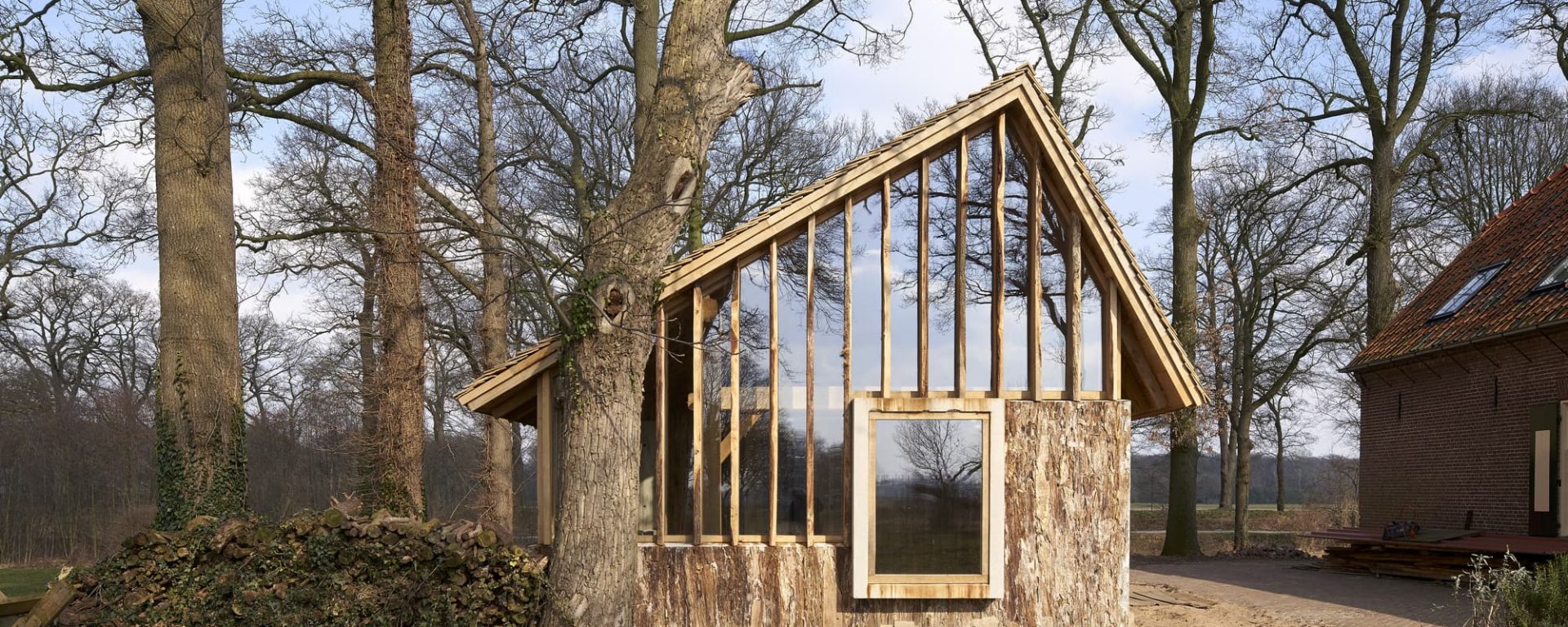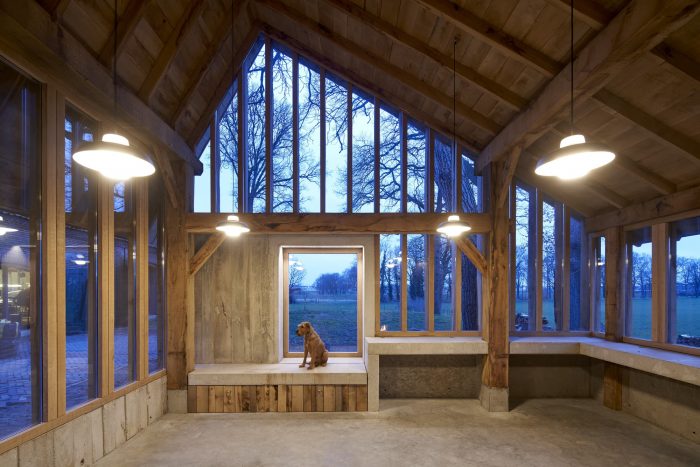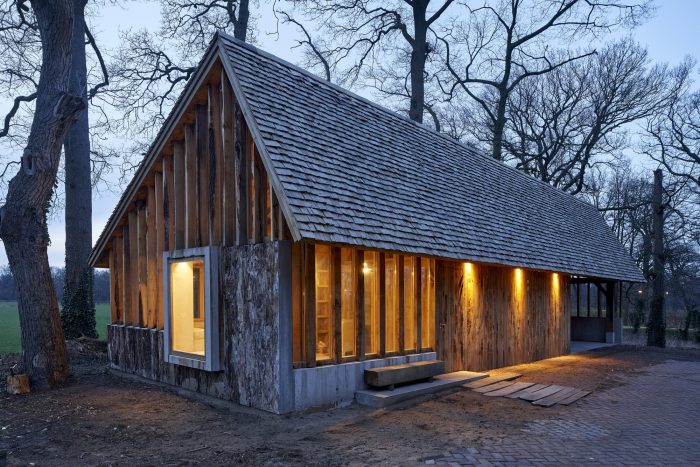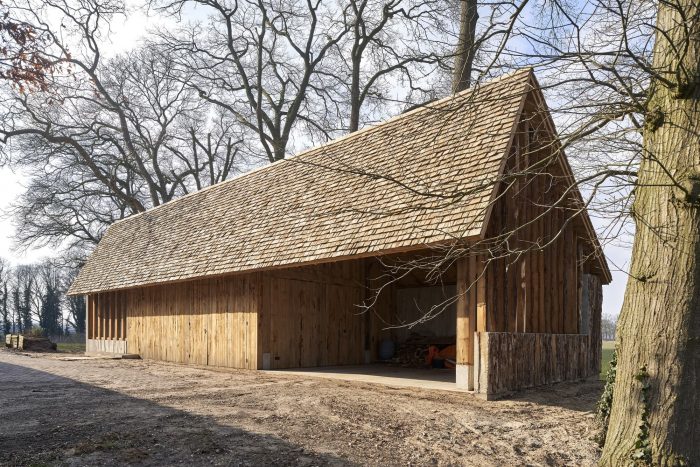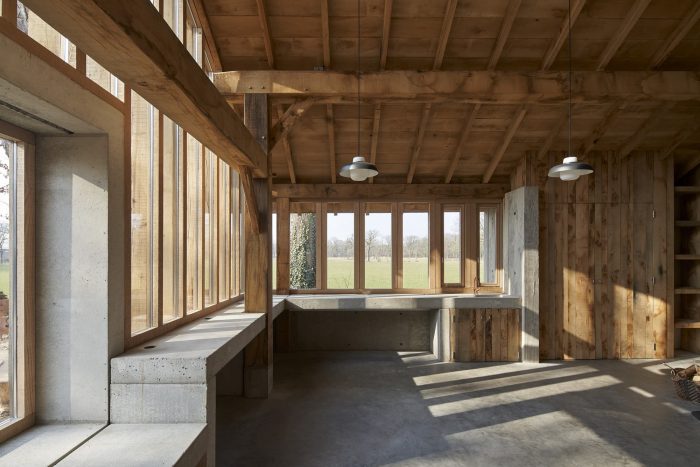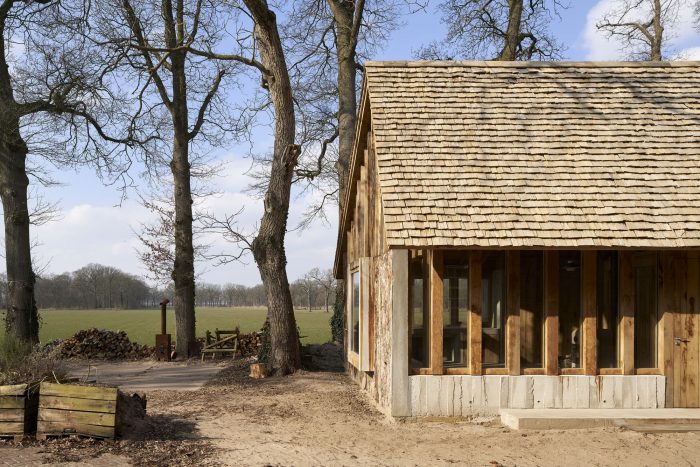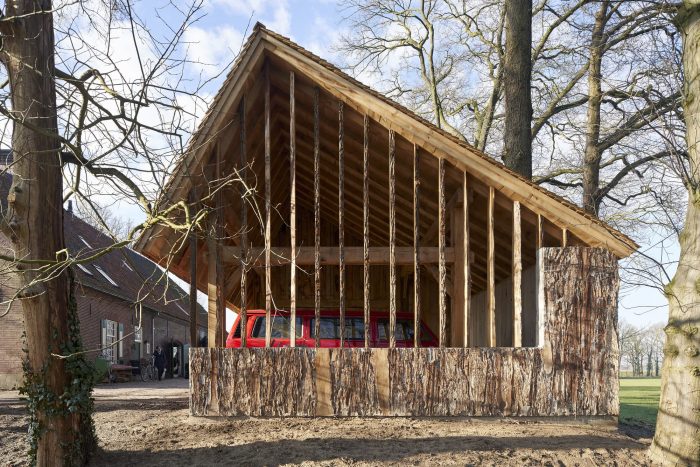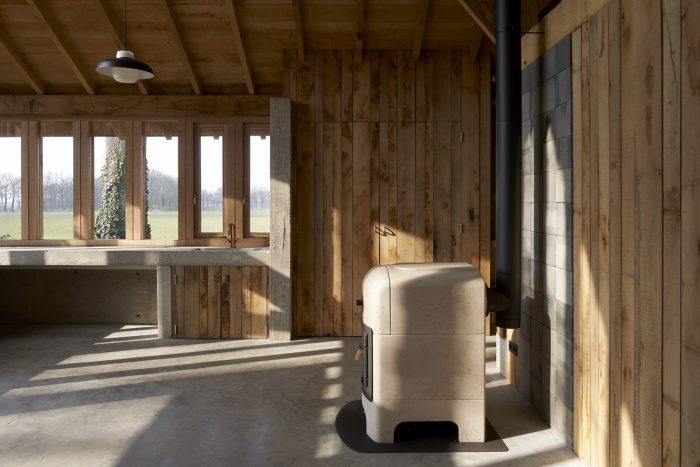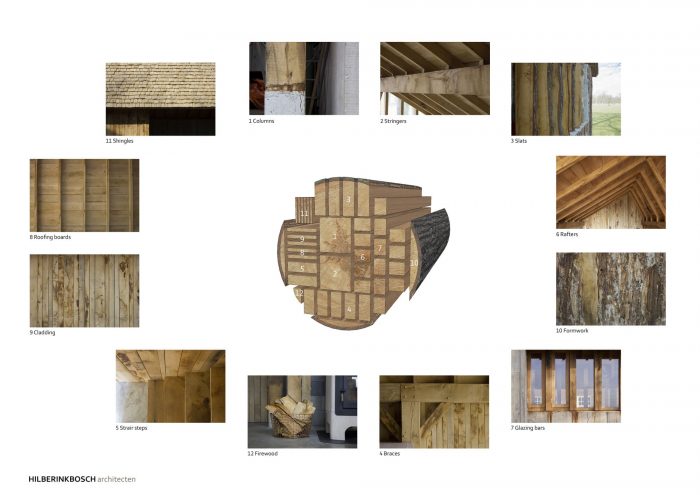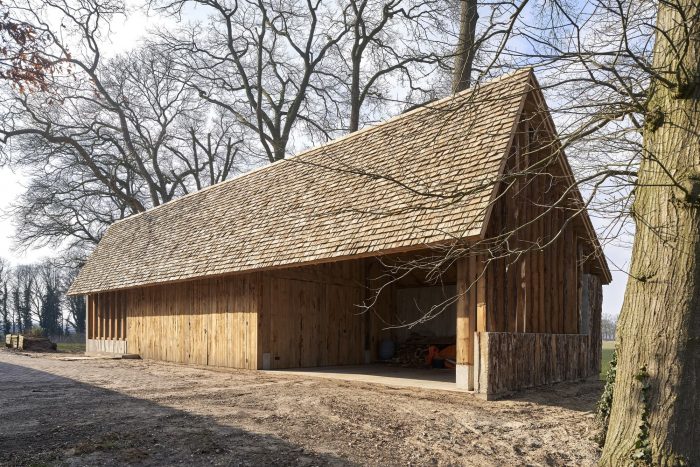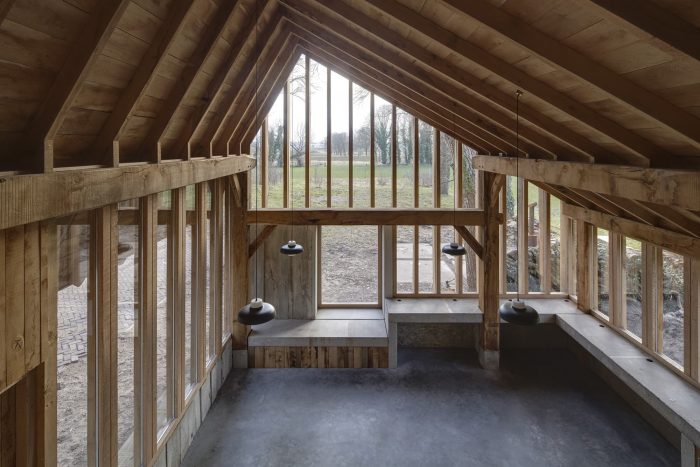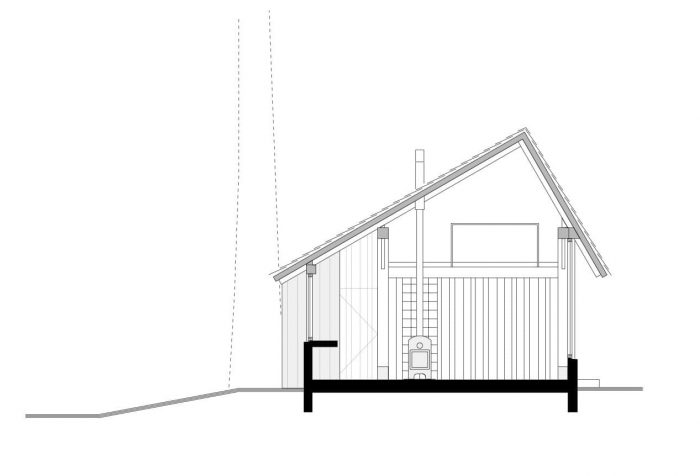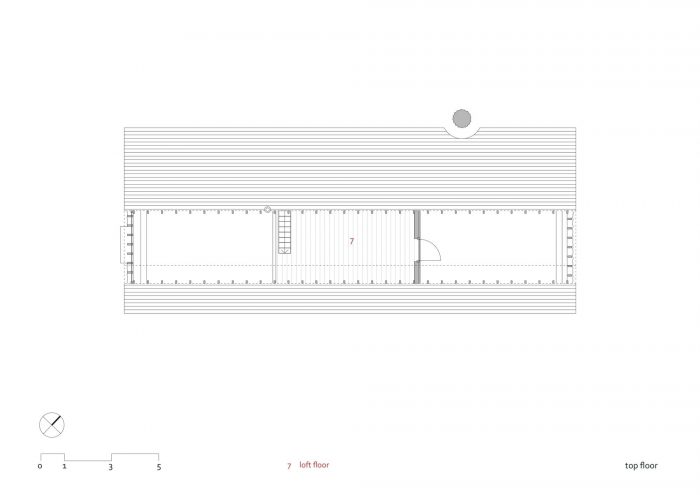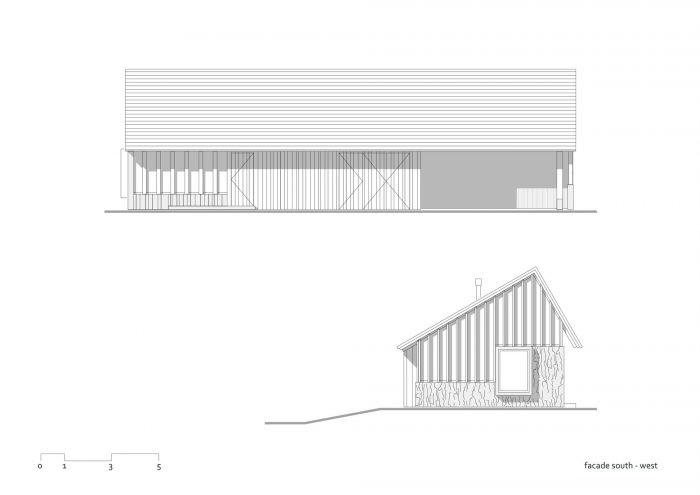传统上,赫托根博斯(Meierij of ‘s Hertogenbosch)的大多数农舍(以前的行政区域或辖区)的独立部分,如生活区、存储空间和牛棚,都集成在一个建筑中。然而,随着时间的推移,这些紧凑的建筑经常变得过于拥挤,无法容纳所有这些功能,于是就增加了一个单独的谷仓。这些建筑通常是用当地可用的材料建造的,并在很大程度上遵循农舍本身的结构模式。
Traditionally, most farmhouses in the Meierij of ’s Hertogenbosch, a former administrative realm or bailiwick, have their separate parts such as living quarters, storage space and cowsheds integrated into a single building. Over time, however, these compact buildings frequently became too cramped to house all of these functions and a separate barn was added. These were usually built from locally available materials and largely followed the structural pattern of the farmhouses themselves.
2017年,我们被告知,我们院子里的七棵百年老橡树状况不佳。他们不得不被砍掉。我们没有走寻常路,把这些树卖给造纸业,而是决定恢复一个古老的传统。因此,通过替换过时的棚屋和大棚,我们将根据我们农场的纪念性特征,用当地收获的材料和传统技术建造一个新的谷仓。除了我们从附近的瓦姆贝格庄园获得的几根橡木树干外,我们不得不砍伐的树木也有足够的木材来建造新谷仓。
In 2017 we were told that seven of the century-old oak trees in our yard were in bad shape. They had to be cut down. Instead of following the usual path and selling the trees to the paper industry, we decided to reinstate an ancient tradition. And so, by replacing a collage of obsolete shelters and sheds, we would, in line with our farm’s monumental character, build a new barn with locally harvested materials employing traditional techniques. Besides a couple of oak tree trunks we obtained from the nearby Wamberg estate, there would be enough timber to construct the new barn from the trees we had to cut down.
我们的新横向谷仓由四根拉杆式夫妇桁架构成,这些桁架由纵向弦杆连接,顶部是由椽子支撑的屋顶。屋顶有一个不对称的几何形状,有一个陡峭的一面和一个低矮的一面。谷仓内有三个空间:一个车棚,一个储藏室和一个用于办公的车间/会议室。储藏室上方的阁楼对车间是开放的。
Our new transverse barn is constructed with four tie-bar couple trusses that are connected by longitudinal stringers topped by a roof supported by rafters. The roof has an asymmetrical geometry with a steep and a low pitched side. There are three spaces inside the barn: a carport, a storage room and a workshop/meeting room for office use. The loft above the storage room is open to the workshop.
一台移动锯木机被带到院子里,用来将新鲜的树干切割成框架和屋顶的结构木材以及外墙的木板。为此,我们从树的核心部分使用质量最好的木材,并为剩余的、不太耐用的部分寻找合适的用途。带有树皮的支架被用作板条,以保护车间和车棚的玻璃。树皮与混凝土混合来建造端墙,这样它们就能与森林环境融为一体。软边材木板被用于混凝土模板,以塑造新鲜木材的印记。短短的木板被劈开,用作屋顶瓦片。这种劈开的木材的粗糙度确保这种未经处理的屋顶可以持续几十年。最后,剩下的被劈开并堆放在谷仓的北面凹陷处作为木柴。
A mobile sawmill was brought to the yard and used to cut the fresh tree trunks into structural timber for the frames and roof as well as planks for the façades. For this we used the best quality wood from the trees’ core sections and went in search of suitable uses for the remaining, less durable parts. Stanchions with bark were employed as slats to shield the glazing in the workshop and carport. Bark was mixed with concrete to construct the end walls so they would blend in with the wooded environment. Soft sapwood planks were used for concrete formwork to mould the imprint of fresh wood. Short lengths were cleaved and used as roofing shingles. The roughness of this cleaved timber ensures that this untreated roofing will last for decades. And finally, the rest was chopped and stacked for firewood in the barn’s recessed north façade.
未经处理的木材、混凝土和玻璃以各种方式混合在一起。用于建造模板的木材的不规则尺寸导致混凝土表面远非完美。边材模板的残余物被嵌入混凝土中,新鲜木材的单宁酸留下了色斑。树木中的铁和钢的内含物,如铁丝网和弹片,大概是1944年的,给木材带来了不完美。这些额外的情况在木材和混凝土中形成了一个意想不到的痕迹层。
Untreated timber, concrete and glass have been intermingled in various ways. The irregular dimensions of the wood used to build the formwork resulted in far from perfect concrete surfaces. Remnants of the sapwood formwork became embedded in the concrete and tannic acid from the fresh timber left discolorations. Iron and steel inclusions in the trees, such as barbed wire and shrapnel, presumably dating from 1944, brought imperfections to the timber. These additional circumstances created an unexpected layer of traces in wood and concrete.
谷仓的美学设计受到了巧合的强烈影响。它使这座当代建筑有了一种重要的表达方式,以一种奇妙而非凡的方式融合了新旧。
The barn’s esthetics have been strongly influenced by coincidence. It lends this contemporary building a vital expression that merges old and new in a wonderful and extraordinary way.
Architects: HilberinkBosch architects
Year : 2018
Photographs :René de Wit
Manufacturers : D-Line, Dick van Hoff Ontwerpen, HIMMEE, Zandenbouw
Lead Architects : Annemariken Hilberink, Geert Bosch
Contractor : Zandenbouw, Aarle-Rixtel
Collaborator : Frenske Wijnen
Sawing : Brabant Hout
Client : project HILBERINKBOSCH at own property
City : Berlicum
Country : The Netherlands

